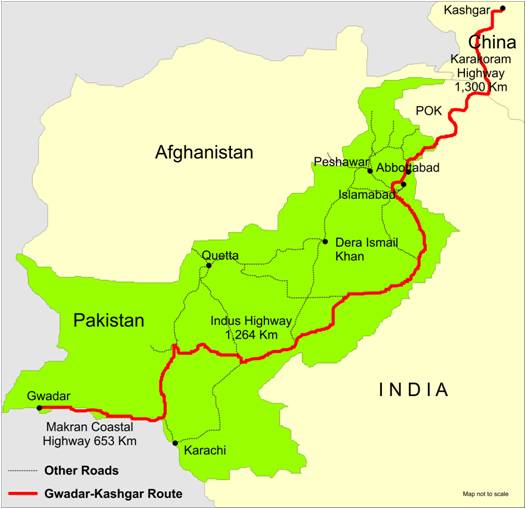IDR Blog
CPEC: a Tale of ‘Iron-Clad’ Friendship and Weak Bridges
Frightening videos of the Hassanabad concrete bridge on Karakoram Highway being washed away in a matter of seconds is a grim reminder of how human apathy towards climate and environment has invited nature’s fury. This incident also reveals the heavy penalty that one has to pay for undertaking infrastructural development with reckless speed and profiteering by cutting corners. The bridge in question is located in Hunza district of Gilgit-Baltistan [GB] in Pakistan Occupied Kashmir [PoK] and has been constructed as part of the ambitious USD 62 billion China Pakistan Economic Corridor [CPEC] project.
Pakistan’s Environment Minister Sherry Rehman has revealed that “Pakistan Climate and Weather department had warned that Pakistan’s vulnerability [on account of flash floods] is high due to high temperatures.” She also disclosed that the “Hassanabad Bridge on the Karakoram Highway collapsed due to a glacial lake outburst flood from the melting Shishper glacier, which caused erosion under pillars.” This incident comes as no big surprise as this glacier has surged several times in the past [1904-05, 1972-76 and 1993-2002] and ever since 2018, a glacial lake outburst flood [GLOF] was expected. Yet, no one seemed to care!
Four years ago, in a seminal piece titled ‘Why don’t CPEC projects factor in the climate crisis?’ [published in ‘China Dialogue’ on January, 3, 2020], Ahmad Rafay Alam, a Pakistani environmental lawyer has made very pertinent observations regarding Islamabad’s gross apathy towards the disastrous impact of this project on the environment. He observes that “while Pakistan’s Ministry of Planning, Development and Reform 2019 document on CPEC’s long-term plan mentions “environment” ten times, but not in the context of the natural world. These are geopolitical, external, macro, market and financing environments.” [Emphasis added].
Alam has also revealed that “The word “sustainable” is used four times [in the plan], but only in the context of economic growth, guidelines and the transport industry. And the plan refers to the climate crisis just once, and that too in the context of the “possible effect of climate change” [Emphasis added]. He also laments that while “A number of pieces in the Pakistani press raise the environmental impacts of CPEC as a rhetorical question.But no one appears to have tried answering it definitively.” [Emphasis added].
He aptly sums up Islamabad’s skewed sense of priorities by noting that “The question of how CPEC will benefit Pakistan has been answered with a strong national narrative of game-changing industrialisation and economic development. But this seems to be getting in the way of a clear and honest answer [on the devastating adverse environmental impact of CPEC].” So, it transpires that due to the indifference of both ‘iron clad’ friends towards the palpable dangers of global warming in terms of glaciers melting rapidly, the Hassanabad Bridge collapse was indeed a tragedy just waiting to happen, and the possibility of similar incidents occurring in the heavily glaciated GB region in the near future cannot be ruled out
While one can do little to prevent GLOFs, yet, basic precautionary measures can always be instituted by incorporating designs that withstand or at least minimise structural damage due to such a threat. In this instance, “erosion under pillars” of this bridge due to gushing waters has been cited as the reason behind the collapse of the Hassanabad Bridge. So, it emerges that while the bridge pillars were strong enough to withstand the force exerted by 8,500 cusecs of water gushing through between 4-4.30 PM, the soil beneath the pillars got washed away causing the bridge to collapse, and this raises a very pertinent question.
Since the bridge was designed and built by Chinese engineers at a place which is highly susceptible to GLOF, why wasn’t the foundation on which the bridge pillars were erected suitably designed and appropriately reinforced to prevent soil erosion? Ever since 2018, experts have been consistently issuing warnings regarding the distinct possibility of an impending GLOF that could threaten Hassanabad Bridge. So, even if adequate anti-erosion measures weren’t incorporated by the Chinese engineers at the time of the bridge construction, why weren’t prophylactic actions to prevent soil erosion not taken for four years despite repeated warnings regarding a GLOF?
In order to save its ‘iron clad’ friend China from embarrassment, as well as conceal its own helplessness in ensuring that Beijing maintains reasonable and internationally acceptable standards of quality control during infrastructure development. Perhaps it’s the realisation that it has no say whatsoever on CPEC related issues that has prompted Islamabad to disband the China-Pakistan Economic Corridor Authority [CPECA], as is evident from the official justification that states that “It [CPECA] is a redundant organisation with a huge waste of resources which has thwarted speedy implementation of the CPEC.”
So, it’s obvious that for the aforementioned reasons, Islamabad is unlikely to seriously investigate the Hassanabad bridge collapse. Nevertheless, this incident has provided a revealing insight into the shoddy way in which China is executing CPEC projects and by disregarding environmental factors just to cut costs, paving the way for natural disasters to occur. Lastly, despite both sides eulogising Sino-Pak friendship as being sweeter than honey, higher than the mountains and deeper than the sea and the more recent ‘iron clad friendship’ sobriquet, the fact of the matter is that when it comes to extracting money, Beijing is nothing less than a Shylock incarnate!





